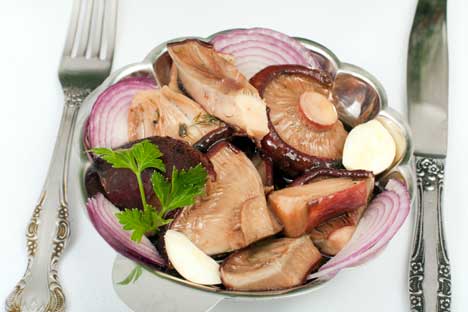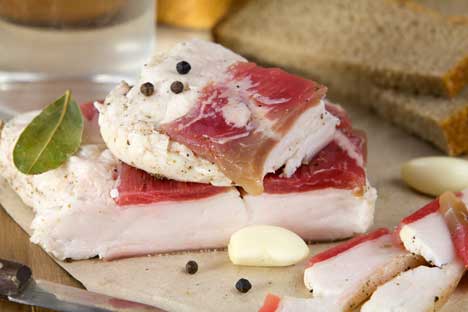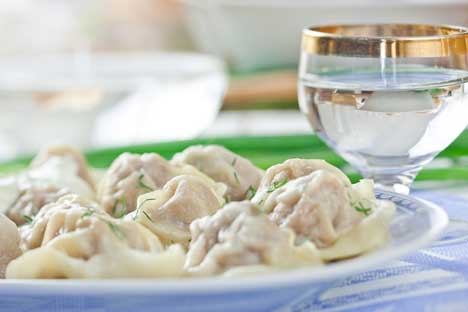To begin with, vodka should be chilled; a bottle of vodka can even be chilled by being placed in the snow, if need be. It is recommended to drink it in small doses, from short liquor glasses or shot glasses. After every glass of vodka one should have a snack, and here Russian culture really amazes with a variety and abundance of snacks and meals intended specifically ‘to go with vodka’.
In Russia, the most popular dishes that ‘go with vodka’ are:
1. Vegetables

Source: Lori / Legion Media
Vegetables preserved in different ways: steeped, soured or salted. The most popular of vegetables preserved in this manner are cucumbers, tomatoes, cabbage with cranberries or blueberries, and Antonovsky apples (a special sour and sweet kind of apple found in Russia). The vegetables are especially tasty when they are steeped and salted in oak barrels. They are usually served chilled with vodka; sometimes before a feast they are also chilled by being placed in the snow.
2. Salted or marinated mushrooms

Source: Lori / Legion Media
Salted or marinated mushrooms: milk mushrooms or saffron milk caps. They are covered with the sunflower oil and sprinkled with the green onions in a salad bowl before serving. Salted milk mushrooms are usually stewed with sour cream; fresh mushrooms fried with potatoes are also an especially tasty compliment to vodka.
3. Herring

Source: Lori / Legion Media
Herring is the most popular fish that goes with vodka in Russia. Its pieces are thickly sprinkled with onion bulbs and chopped greens. They are also usually flavored with sunflower oil and vinegar. As a rule, herring is served with hot-boiled potatoes and garnished with butter, chopped dill and special rye bread. This trio of vodka, herring and potato is considered to be a classic accompaniment to vodka in Russia.
4. Caviar

Source: Lori / Legion Media
Red or black caviar. If we consider black sturgeon caviar, then gray or beluga caviar is the more exquisite variety. Caviar is usually served on small, white bread pieces with butter. If caviar is served as a separate dish, the bowl with caviar is placed on chipped ice.
5. Lard or ham.

Source: Lori / Legion Media
The most delicious lard is from the bottom of the pork carcass – ‘podcherevina’, as it is called, is a thin piece that usually consists of three or four layers of meat. The lard is especially tasty if the skin is tarred with straws and twisted into braids. Lard is usually served chilled with raw onion bulbs or garlic.
6. Meat jelly.

Source: Lori / Legion Media
The jelly from a pig's head, rich beef bones and rooster are especially popular, because the broth creates a rich amber color and a particular taste. The famous Russian root – grated horseradish or mustard‒ is traditionally served with these various kinds of meat jelly.
7. Russian pancakes.

Source: Lori / Legion Media
Russian pancakes are consumed only with vodka. The hot pancakes are flavored with melted butter, topped with sour cream and caviar, and sprinkled with finely chopped green onions. This is a traditional dish for the famous Russian holiday Maslenitsa, which celebrates the approach of winter’s end.
8. Salad 'Olivier'

Source: Lori / Legion Media
The famous Russian salad ‘Olivier’ or another well-known but less popular ‘Beetroot salad.’ ‘Olivier’ is a mixture of finely chopped boiled eggs, sausages and marinated cucumbers, seasoned with the mayonnaise sauce. ‘Beetroot salad’ is composed of kraut, diced boiled beets and white beans. Salads are an essential part of any Russian meal on the eve of Russia’s biggest holiday, New Year.
9. Dumplings

Source: Lori / Legion Media
Siberian meat dumplings or vareniki. Vodka is the classic drink to accompany hot dumplings. Siberian dumplings are served with sour cream or mayonnaise and sprinkled with black ground pepper. Vareniki are especially tasty with potatoes and mushrooms. Vareniki are often abundantly sprinkled with the chopped onions that have been braised in butter.
10. Suckling pig

Source: Lori / Legion Media
Fried or baked suckling pig. This is either served with sour cream and horseradish (in classic Russian style), or, stuffed with buckwheat porridge and roasted. A distinctive aftertaste remains when a glass of cold vodka is followed by a piece of hot meat.
11. Meat

Source: Lori / Legion Media
Boiled or roasted meat – beef or veal. A piece of cooked meat, cold roasted pork, or meat simply baked in the dough – all of these dishes require vodka to accompany them.
12. Borscht or Russian cabbage soup.

Source: Lori / Legion Media
These are rich, thick, meaty soups. Essential components of borscht are beets and tomatoes, unlike the Russian cabbage soup. Borscht is necessarily served with sour cream and bread sprinkled with finely chopped garlic. Some people like to add a glass of vodka to a bowl of hot borscht.
All rights reserved by Rossiyskaya Gazeta.
Subscribe
to our newsletter!
Get the week's best stories straight to your inbox